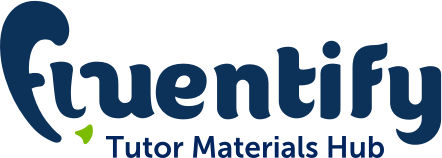If, during the placement test, you discover that your student is a complete beginner you should immediately stop the test and move on to their first lesson; ‘to be’ verb.
Worksheet: office objects
To conduct your first session you should use this picture worksheet. You can share the worksheet with your student by sharing your screen or sending it to them in the chat using the clip icon.

PDF download office objects
How to teach ‘to be’
Step one: Share your screen with your student and go through the names of four or five of the singular objects. Each time say, ‘it is a …..’.
Step two: Next, highlight that, ‘it is’ is contracted to, ‘it’s’. Ask your student to name the objects themselves using ‘it’s a….’. For example, ‘it is a computer’, ‘it is a plant.’
Step three: Start asking questions. Make sure that your student understands that you have to reverse ‘to be’ and the subject pronoun by writing the sentences in the messages and crossing your hands over themselves as you’re asking the question.
First ask questions that are true. For example, point to the cell phone and ask, ‘is it a phone?’ Elicit, ‘yes, it’s a phone’.
Next ask questions that are not true. For example, point to the computer and ask, ‘is it a plant?’
Your student will say, ‘no.’
Write the negative answer in the messages: ‘No, it’s not a plant.’ Ask them to repeat what you have said.
Ask your student another question that is not true and get them to answer with a full negative sentence. Continue this until your student is happy answering in affirmative and negative.
Step four: Make a questioning gesture and say, ‘ask me,’ or, if they don’t understand, ‘question me.’ If your student doesn’t understand, then use Google Translate to find the translation and ask them in their language. In Italian ‘ask me’ is ‘Chiedimi’ /kyeh-di-mi/ .
Using the correct question form, your student should be able to ask questions like, ‘Is it a pencil?’
Step five: If your student is making good progress, start using the interrogative pronoun ‘what’ and ask, ‘what is this?’ rather than, ‘is it…?’
Ask your student to start asking you their own questions using ‘what.’
Step six: If everything is going really well, next, start naming plural nouns and introduce ‘they’. For example, ‘they are bank cards’, or, ‘they are keys.’
Step seven: Repeat the process, now with plural nouns by pointing to different objects and asking questions; some which are true and some which are false. With a false question, elicit the response ‘no, they are not keys.’ Next ask, ‘what are they?’ and elicit an answer. Finally get your student to ask you about different objects.
Ending the session and homework
Wherever you are in these steps, stop five minutes before the end to tell your student that they are doing very well and that you will continue with the subject next lesson.
If they are keen on homework you could give them this simple podcast from ELLLO about colours to listen to which includes lots of example of singular and plural ‘to be.’
In addition, send them the picture that you used in the lesson and ask your student to write a few sentences with ‘to be’ in affirmative, negative and interrogative for next lesson.
This is a complicated instruction and so you should write it in the messages as well as instruct your student verbally. If necessary, copy and paste the translation from Google Translate.
Thank your student for their time. Give them lots of positive vibes by telling them how well they have done with smiles and a thumbs up.
End the session.

